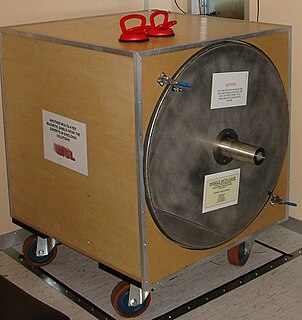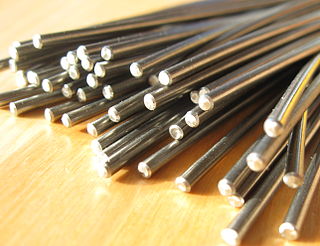 W
WAlnico is a family of iron alloys which in addition to iron are composed primarily of aluminium (Al), nickel (Ni), and cobalt (Co), hence acronym al-ni-co. They also include copper, and sometimes titanium. Alnico alloys are ferromagnetic, and are used to make permanent magnets. Before the development of rare-earth magnets in the 1970s, they were the strongest type of permanent magnet. Other trade names for alloys in this family are: Alni, Alcomax, Hycomax, Columax, and Ticonal.
 W
WThe Hiduminium alloys or R.R. alloys are a series of high-strength, high-temperature aluminium alloys, developed for aircraft use by Rolls-Royce ("RR") before World War II. They were manufactured and later developed by High Duty Alloys Ltd. The name Hi-Du-Minium is derived from that of High Duty Aluminium Alloys.
 W
WHaynes International, Inc., headquartered in Kokomo, Indiana, is one of the largest producers of corrosion-resistant and high-temperature alloys. In addition to Kokomo, Haynes has manufacturing facilities in Arcadia, Louisiana, and Mountain Home, North Carolina. The Kokomo facility specializes in flat products, the Arcadia facility in tubular products, and the Mountain Home facility in wire products. In fiscal year 2018, the company's revenues were derived from the aerospace (52.1%), chemical processing (18.2%), industrial gas turbine (12.0%) and other (12.3%) industries. The company's alloys are primarily marketed under the Hastelloy and the Haynes brands. They are based on nickel, but also include cobalt, chromium, molybdenum, tungsten, iron, silicon, manganese, carbon, aluminum, and/or titanium.
 W
WInconel is a registered trademark of Special Metals Corporation for a family of austenitic nickel-chromium-based superalloys.
 W
WInvar, also known generically as FeNi36, is a nickel–iron alloy notable for its uniquely low coefficient of thermal expansion. The name Invar comes from the word invariable, referring to its relative lack of expansion or contraction with temperature changes.
 W
WKovar is a nickel–cobalt ferrous alloy compositionally identical to Fernico 1, designed to have substantially the same thermal expansion characteristics as borosilicate glass to allow a tight mechanical joint between the two materials over a range of temperatures. It finds application in glass-to-metal seals in scientific apparatus, and conductors entering glass envelopes of electronic parts such as vacuum tubes (valves), X-ray and microwave tubes and some lightbulbs.
 W
WManganin is a trademarked name for an alloy of typically 84.2% copper, 12.1% manganese, and 3.7% nickel. It was first developed by Edward Weston in 1892, improving upon his Constantan (1887).
 W
WIn metallurgy, melchior is an alloy of copper, mainly with nickel (5–30%). Its name originates from Italian: melchior, which in turn is distorted French: maillechort, honoring the French inventors of the alloy, Maillot and Chorier. The term melchior sometimes refers not only to the copper-nickel alloys, but also ternary alloys of copper with nickel and zinc and even a silvered brass. Melchior is easily deformable by application of pressure, both in the hot and cold state. After annealing, it has a tensile strength of about 40 kg/mm2. The most valuable property of melchior is its high resistance to corrosion in air, freshwater and seawater. Increasing content of nickel, iron or manganese improves corrosion and cavitation resistance, especially in sea water and atmospheric water vapor. The alloy of 30% Ni, 0.8% Fe, 1% Mn and 68.2% Cu is used in maritime shipping, in particular for the manufacture of condenser tubes. Nickel gives melchior, unlike brass and bronze, a silver color, and that property, combined with its high corrosion resistance, made it popular for the manufacture of household utensils in the Soviet Union, though more recent research has concluded that nickel is mildly carcinogenic when used in food preparation and consumption.
 W
WMonel is a group of nickel alloys, primarily composed of nickel and copper, with small amounts of iron, manganese, carbon, and silicon. Alloys with copper contents 60% or more are called cupronickel.
 W
WMu-metal is a nickel–iron soft ferromagnetic alloy with very high permeability, which is used for shielding sensitive electronic equipment against static or low-frequency magnetic fields. It has several compositions. One such composition is approximately 77% nickel, 16% iron, 5% copper, and 2% chromium or molybdenum. More recently, mu-metal is considered to be ASTM A753 Alloy 4 and is composed of approximately 80% nickel, 5% molybdenum, small amounts of various other elements such as silicon, and the remaining 12 to 15% iron. The name came from the Greek letter mu (μ) which represents permeability in physics and engineering formulae. A number of different proprietary formulations of the alloy are sold under trade names such as MuMETAL, Mumetall, and Mumetal2.
 W
WNickel pig iron (NPI) is a low grade ferronickel invented in China as a cheaper alternative to pure nickel for the production of stainless steel. The production process of nickel pig iron utilizes laterite nickel ores instead of pure nickel sold on the world market. The alternative was developed as a response to the high price of pure nickel. The estimated cost of a ton of nickel pig iron ranged between US$16,500 and $18,000 in 2012, and this cheaper substitute for pure nickel influences the price of nickel on the world market by lowering the demand in certain applications, the most important being the production of stainless steel, representing about two-thirds of nickel use.
 W
WNickel silver, Maillechort, German silver, Argentan, new silver, nickel brass, albata, alpacca, is a copper alloy with nickel and often zinc. The usual formulation is 60% copper, 20% nickel and 20% zinc. Nickel silver is named due to its silvery appearance, but it contains no elemental silver unless plated. The name "German silver" refers to its development by 19th-century German metalworkers from the Chinese alloy known as paktong or baitong (白銅). All modern, commercially important nickel silvers contain significant amounts of zinc, and are sometimes considered a subset of brass.
 W
WNickel titanium, also known as Nitinol, is a metal alloy of nickel and titanium, where the two elements are present in roughly equal atomic percentages. Different alloys are named according to the weight percentage of nickel; e.g., Nitinol 55 and Nitinol 60. It exhibits the shape memory effect and superelasticity at different temperatures.
 W
WNickel titanium, also known as Nitinol, is a metal alloy of nickel and titanium, where the two elements are present in roughly equal atomic percentages. Different alloys are named according to the weight percentage of nickel; e.g., Nitinol 55 and Nitinol 60. It exhibits the shape memory effect and superelasticity at different temperatures.
 W
WPermalloy is a nickel–iron magnetic alloy, with about 80% nickel and 20% iron content. Invented in 1914 by physicist Gustav Elmen at Bell Telephone Laboratories, it is notable for its very high magnetic permeability, which makes it useful as a magnetic core material in electrical and electronic equipment, and also in magnetic shielding to block magnetic fields. Commercial permalloy alloys typically have relative permeability of around 100,000, compared to several thousand for ordinary steel.
 W
WRaney nickel, also called spongy nickel, is a fine-grained solid composed mostly of nickel derived from a nickel–aluminium alloy. Several grades are known, of which most are gray solids. Some are pyrophoric, but most are used as air-stable slurries. Raney nickel is used as a reagent and as a catalyst in organic chemistry. It was developed in 1926 by American engineer Murray Raney for the hydrogenation of vegetable oils.
 W
WVDM Metals Group based in Werdohl, Germany, is a manufacturer of corrosion-resistant, heat-resistant and high-temperature nickel alloys, cobalt and zirconium alloys as well as high-alloyed special stainless steels. These materials are used in the chemical process industry, the oil and gas industry, aerospace, automotive and electronics / electrical engineering. VDM Metals operates production sites in Germany and the United States. The company employs about 2,000 people worldwide.
 W
WWaspaloy is a registered trademark of United Technologies Corp that refers to an age hardening austenitic nickel-based superalloy. Waspaloy is typically used in high temperature applications, particularly in gas turbines.